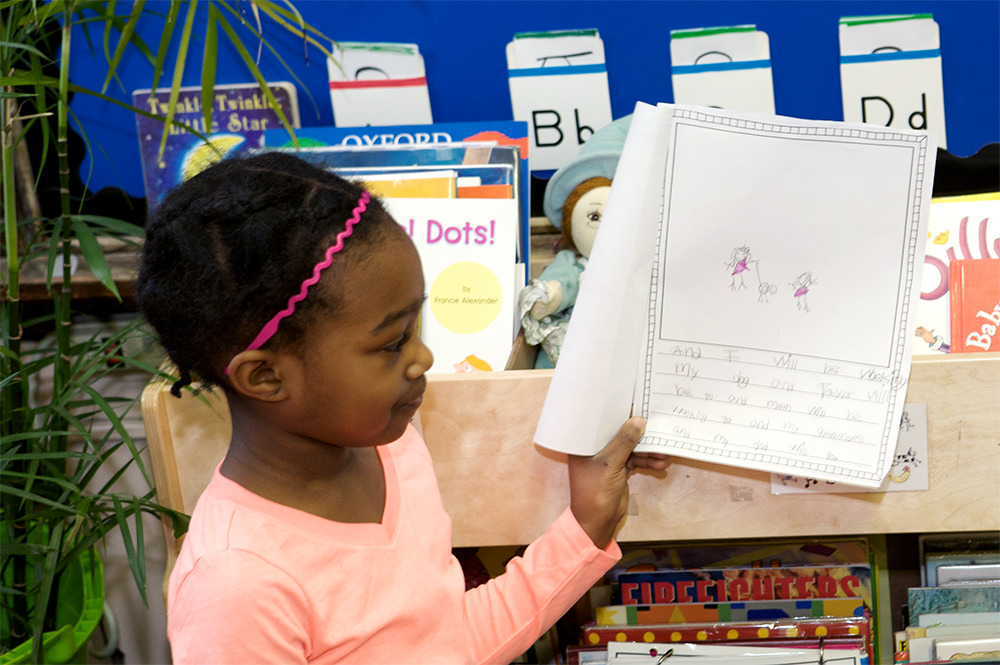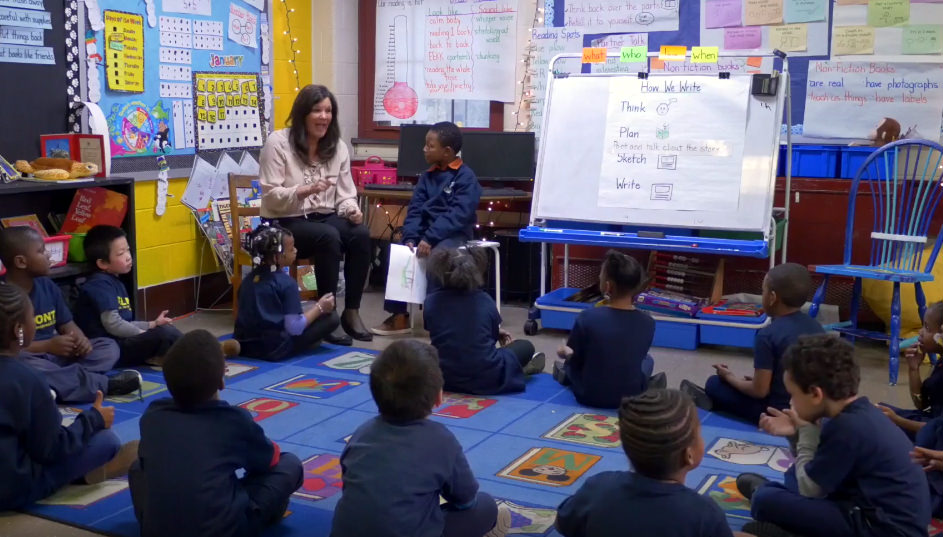Share Time
Writing Workshop Share - Writers Start With A Feeling
Spotlight on Share Time
A spotlight on a conference and for more information on its importance to the Writing Workshop structure.
Share time at the end of each Writing Workshop gives children the opportunity to share their ideas and words with a learning community and brings your workshop full circle.
Gather the class at the large group meeting area to reinforce the literacy objective, reflect upon your work as writers, and bring closure to work time. Share time is the shortest part of the Writing Workshop, lasting about five minutes.
Prepare for a meaningful share time as you are working with children during work time. As you are conferencing each day, be on the lookout for someone who has tried what you have demonstrated in your mini-lesson. Invite this writer to share their accomplishment or learning with the class. You may invite one to three children to share, each with a purpose in mind. Keep a list of these writers to assure that everyone who wants to share in this way gets their chance. Children who are sharing that day bring their piece of writing to the whole group area.
Share Time Supports a Writing Community
We often refer to writing as a social act. People write to affect the thoughts, feelings, and lives of others. The share session provides a time for children to read, speak about, and to listen to their own writing work and the work of others.
Share time is a way that children learn from each other. After being presented with various ideas and styles from their author peers, children will often try these in their own work. Share time is how good ideas “take off” and spread in your classroom.

Through share time, younger writers become more aware that there is an audience for their writing work. As they compose, they begin to internalize what information their readers need for meaning. The reader can check and see if the piece is working in the way they had intended. Did my audience laugh at the funny parts? Did they look sad when I shared the sad parts? They are validated as writers when their peers take notice.
Sharing in a large group setting also models for children how to share in small groups on their own. It gives children a common academic language with which to talk about writing and helps them practice their listening skills. The language of the mini-lessons becomes the language they use while they confer with each other. “I heard a strong lead in your story that made me want to read more!” “I heard four reasons to support your opinion that we should wear uniforms in school.”
Share time shows children that what they have to say matters. That we write to communicate and connect with others and that writing can be a place to reflect, grow, and discover just what is important to us. It gives us a glimpse into an author’s thinking and how they see the world. It makes us think!
Getting and Giving Feedback
Authors need attentive listeners after they finish a draft. Focusing on one detail that leads to improved clarity and comprehension by the listening audience helps children see the benefits of revision. Modeling how to give positive and useful feedback to children will help them to see how this can be done with their own peers to build trust, encourage self-assessment, and foster risk taking in writing.
Share time may look slightly different or serve different purposes each day. Plan how to hold children’s interest and allow everyone to participate and engage. Some children will be eager to share what they practiced that day and share their stories. Others may need more support from you to share their ideas. Encouraging all children to share sends the message that everyone has something valuable to contribute to the writing community. Even the illustrations of our youngest of writers can be explained and given feedback. Try the ideas below to increase the amount of talk time your writers use with each other:
I’m sharing a writing victory.
“Victor added a concluding sentence to his piece! After he reads the last part, give a thumb’s up if it sounds like his piece is finished.” What did you hear?
I have a connection to the mini-lesson.
“We learned that using specific verbs in our writing can help the reader ‘see’ the action. As Zamir reads, what words help you to see the action?”
I tried something new.
“Writers, we have been making sure our fiction stories have a problem to solve. Listen how Sara writes her problem at the very beginning. Is this something you can try?”
I used a word that was just right for this part.
“Read this part and tell us why you chose the word ‘raced’ instead of ‘went’.”
I have a writing problem, can you help solve it?
“Friends, when I read this part, can you tell me if you understand that I didn’t want the game to end?”
I tried a technique I borrowed from a mentor text.
“We learned how to describe a setting from Twilight Comes Twice. Listen to the setting in my story.”
Read and share a process.
“Where did you get the idea for this story?”
Writing in progress.
“Where will you go from here?”
You may start out by helping each writer to share a part of their writing. If a child is reluctant to share you can ask, “May I read this part out loud?” Or think about having them share with a good friend during work time.
As your writers progress, you can gradually release more of the share time to them, beginning with a guiding question to the audience, moving toward having them introduce the reason of the share by themselves and asking questions to the group. Focus on ideas the children can apply to all of their writings, instead of just that particular piece. Your objective is for the authors to do most of the speaking and most of the learning!
Mix up how children interact with each other during share time. Try using turn and talk with partners, small groups for revision ideas, and occasionally having all children share one quick item, for example their title if the mini-lesson was about crafting an original title instead of The Time I Went to the Park.
Literacy Environment
You can design your literacy environment to support share time in many ways.
Space
Ending your Writing Workshop by gathering in the whole group area where the mini-lesson began can help give closure to the workshop. Children often sit in a circle around the perimeter of the carpet so that they are facing one another while they talk.
Consider the use of an author’s chair for share time. A special place for sharing can help make the author feel valued and feel some manner of control while sharing. It allows classmates to use good listening skills such as “eyes on the speaker” and “one voice at a time.”
Having your current mini-lesson anchor chart or a list of writing strategies near the large group area will provide visuals and reminders for your writers. It will also remind children of some ideas for feedback they can give to the author. As children make connections to the mini-lesson and to concepts learned previously, you can make reference to the strategies that strong writers use, applying this learning to future pieces.
Time
You may have thought about skipping share time, forgetting to set a signal or being lured by the possibility of just a little more work time. Share time is another opportunity to reflect and assess. When children feel a routine to the Writing Workshop (learn a strategy, try it out, share in context how it works) writers grow stronger and more confident. When they expect the same routines each day, writers compose when they’re not actually writing – on the bus, before they sleep, gathering ideas they can write about tomorrow. Sharing celebrates the hard work of putting thoughts to paper and affirms the joy of living a writerly life!


Comments (26)
Log in to post a comment.